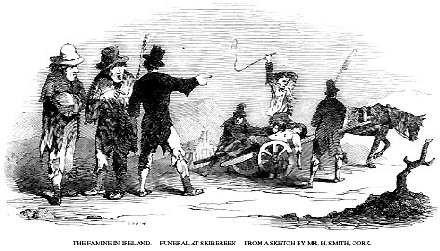Lesson 5: Apprehending Plant Killers
Funeral For Famine Victim
Introduction
“Apprehending plant killers” is the final lesson designed to have students select a particular type of plant pathogen, research this particular microbe and then create a wanted poster product to educate their peers and the public of the impact of this plant disease. Plant pathogens can kill crops and have historically cost human lives and today contribute to billions of dollars of economic losses and less food to a growing world. “Confronting a Killer” is as a part of the module “CSI Dublin: The Hunt for the Irish Potato Killer.” “CSI Dublin: The Hunt for the Irish Potato Killer” is an integrated project incorporating science concepts of earth science, biology, biotechnology and art to allow students to apply their understandings of epidemiology and plant pathology into the historical context of science and human health. This unit plan would be best used after previous units or discussions on DNA, biotechnology, taxonomy, bacteria, viruses, plants, protists, fungi and immunity.
Learning Outcomes
- The learner will select a plant pathogen of their particular interest.
- The learner will use Library and internet resources to research their plant pathogen.
- The learner will create a “Wanted Poster” product outlining the danger of the pathogen to the public.
Curriculum Alignment — National
- Content Standard C: “As a result of activities in grades 9-12, all students should develop understanding of: The Cell, Interdependence of organisms, Behavior of organisms ”
- Content Standard E: “As a result of activities in grades 9-12, all students should develop Abilities of technological design, Understandings about science and technology”
- Content Standard F: “As a result of activities in grades 9-12, all students should develop understanding of: Population growth.”
Curriculum Alignment — State
- North Carolina Standard Course of Study for Biology, Goal 3.02
- North Carolina Standard Course of Study for Biology, Goal 4 (all)
- North Carolina Standard Course of Study for Biology, Goal 5.01
Classroom Time Required
This lesson requires 100 minutes of class time, depending on student abilities levels, resources, and library availability.
Pre-activity discussion: 5 minutes depending on student questions.
Student Activity: 90 minutes, depending on resources available.
Post-activity discussion: 5 minutes depending on student questions.
Prior Knowledge/Vocabulary
Students should understand the steps of the scientific method, pathogen, host, general epidemiological terms (susceptibility, occurrence) taxonomy, ecology, symbiotic relationships (parasitism,) bacteria, viruses, Oomycetes and fungi.
Materials Needed
- Lab Sheet and Rubric
- Clean printer paper, colored pencils, pens, glue sticks, scissors, rulers
- Handouts of the 4 Fact Sheets: Bacterial, Viral, Nematode and Fungal and Fungus-like.
- A copy of list of plant diseases to help students decide and record their choices.
Technology Resources
- Students will need access to a print or computer resources for them to access online journals and internet resources.
Activities
- To open the activity, the teacher should display an old time wanted poster to show students how authorities warned the public to be on the lookout for dangerous criminals. An example is here http://www.flickr.com/photos/freeparking/468947144/
- The teacher will explain in order to prevent the spread of pathogens, the biology of the pathogen must be researched to identify its unique characteristics and to warn people about its spread. Students should brainstorm how different types of cause different symptoms and look different underneath the microscope. Students should then select a plant pathogen available for them to research from the suggested list.
- Using that information, students should create a hypothesis based upon the information from their observations as well as the pre-lab discussion. Make sure all students have recorded their own unique hypotheses before they begin their laboratory activity. (See comments section.)
- They should begin their research focusing on the 10 questions on their lab sheet. You may wish to provide students with a copy of the grading rubric so they can see how they are going to be assessed. Remind students to record their sources and look for concrete data including percentages, ratios, and other numbers (quantitative data) as well as qualitative data.
- As students finish their research, they should use a program such as Word or Publisher to create their Wanted Posters.
- The student final projects should be their Lab sheet and Wanted Posters.
- Assure students that only their data questions will be assessed upon accuracy whereas the rest of their score depends on the thought and quality of their responses. Ensure that all students are able to complete the assignment. (See Modifications Section)
Assessment
- The teacher will score the Wanted Poster based upon the grading rubric provided. It is recommended that the teacher create a Wanted Poster of P. infestans to use as sample work.
Modifications
- For ESL and ELL students, they may use an online translator such as Babelfish (http://babelfish.yahoo.com/) to translate entire web pages into their preferred language for information about their plant pathogen. (See Websites)
Extensions
Websites
Comments
- It is important for students to understand the importance of observations in formulating a hypothesis. Teachers should foster the creative and unique thought process that the hypothesis requires and emphasize that there is no “right or wrong” answer, only supported or not supported.
- As students are conducting their online research, it is important they use peer reviewed or otherwise credible resources. They should use well known entities like the American Phytopathological Society (APS), scientific journals, or government (.gov) and universities (.edu) websites. Looking at Wikipedia might be a good start, but they should use the external links below to search for their information going into their report.
Sources/Credits
- Chia-Hui “Julia” Hu, post-doctoral researcher in the department of Plant Pathology at North Carolina State University under the direction of Dr. Jean Beagle Ristaino, professor of Plant Pathology.
- http://ohioline.osu.edu/hyg-fact/3000/ Amazing web resource of Plant Pathogens from Ohio State University. This is the source of the fact sheets that students can use.
